the polish-jewish-ukrainian relations in wielkie oczy - JewishGen ...
the polish-jewish-ukrainian relations in wielkie oczy - JewishGen ...
the polish-jewish-ukrainian relations in wielkie oczy - JewishGen ...
You also want an ePaper? Increase the reach of your titles
YUMPU automatically turns print PDFs into web optimized ePapers that Google loves.
• Lypa - was a poor Jew (brought water to richer people,<br />
and <strong>in</strong> this way earned a liv<strong>in</strong>g)<br />
In Wielkie Oczy <strong>the</strong>re were three Jewish dairies. Jews also<br />
worked <strong>in</strong> handicrafts. They owned two big tailor<strong>in</strong>g enterprises,<br />
and <strong>the</strong>y also taught Poles to sew. There were also two bakeries.<br />
Only Jews worked <strong>in</strong> <strong>the</strong> bakeries. The made bread, bread<br />
rolls and sweet buns, which <strong>the</strong>y called lejka. Jews distributed<br />
<strong>the</strong>m personally to <strong>the</strong> houses (<strong>the</strong>y went to <strong>the</strong> houses, where<br />
<strong>the</strong>y expected to be paid for <strong>the</strong>ir products or to get some<br />
goods, milk for example). They also dealt with mobile trade.<br />
They engaged for this reason carters with carts and horses.<br />
(Jews <strong>the</strong>mselves didn’t raise horses).<br />
Jews didn’t kill animals at <strong>the</strong>ir houses. Slaughter<strong>in</strong>g was done<br />
<strong>in</strong> slaughterhouses, so called jatka. There were four slaughterhouses<br />
and 4 <strong>in</strong>ns managed by Jews, where ma<strong>in</strong>ly alcohol<br />
dr<strong>in</strong>ks were served and visitors brought someth<strong>in</strong>g to eat.<br />
Polish and Jewish children learned toge<strong>the</strong>r <strong>in</strong> <strong>the</strong> school. They<br />
attended all lessons toge<strong>the</strong>r, except for religion. Before <strong>the</strong><br />
religion lessons Jews left <strong>the</strong> classroom. Beside <strong>the</strong> primary<br />
school <strong>in</strong> Wielkie Oczy were two Jewish schools, so called<br />
cheders. Probably, <strong>the</strong> religion was taught <strong>the</strong>re.<br />
Jews helped <strong>the</strong> poorer of <strong>the</strong>m.<br />
The bath was managed by <strong>the</strong> Jew Mojsiu. Poles took <strong>the</strong>re<br />
baths as payment. It was <strong>in</strong> a wooden house. It stood <strong>in</strong> <strong>the</strong><br />
place called Pasternik, beh<strong>in</strong>d <strong>the</strong> synagogue. Inside was<br />
wooden well with crank. Close to <strong>the</strong> well was a pool called a<br />
kuszer only for Jews. For Poles <strong>the</strong>re was a special room with<br />
wooden bathtubs. Hot water was taken from a boiler (a lot of<br />
steam went from it). Close to <strong>the</strong> boiler were about eight<br />
wooden stairs. People sat on <strong>the</strong>m. It was a k<strong>in</strong>d of sauna. Inside<br />
it was semi-dark because <strong>the</strong> light came from one paraff<strong>in</strong><br />
lamp. Poles used to take a bath on Saturday even<strong>in</strong>g after <strong>the</strong><br />
Sabbath (before Sunday). Jews took <strong>the</strong>ir bath on Friday, because<br />
<strong>the</strong>ir Sabbath began Friday afternoon. Dur<strong>in</strong>g Sabbath<br />
Jews did not work, and <strong>the</strong>y would pay a so called goy to<br />
work. On Saturdays <strong>the</strong>y always ate chicken broth with potatoes.<br />
They also ate veal, but only <strong>the</strong> front parts of <strong>the</strong> animal.<br />
The back parts <strong>the</strong>y sold. Dur<strong>in</strong>g Saturdays <strong>the</strong>y prayed <strong>in</strong> <strong>the</strong><br />
synagogue and afterward celebrated <strong>the</strong> holiday at home with<br />
<strong>the</strong>ir families. Dur<strong>in</strong>g some holidays, probably <strong>in</strong> October, but I<br />
don't know what holidays <strong>the</strong>y were, Jews prayed <strong>in</strong> so called<br />
kuczki. It was like our summer-kitchen. The walls were made<br />
from bean-stalks. Dur<strong>in</strong>g holidays <strong>the</strong>y used o<strong>the</strong>r kitchen utensils<br />
<strong>the</strong>n dur<strong>in</strong>g <strong>the</strong> week-days.<br />
Dur<strong>in</strong>g holidays <strong>in</strong> spr<strong>in</strong>g Jews ate matzo. It is big, th<strong>in</strong> bread<br />
baked on leaven.<br />
Jewish wedd<strong>in</strong>g ceremonies, so called mazaltop, were held on<br />
Saturday even<strong>in</strong>gs. The ceremony was held <strong>in</strong> <strong>the</strong> synagogue<br />
or close to it under a canopy that looked like umbrella. On <strong>the</strong><br />
way out <strong>the</strong>y broke glasses. A modest party was held at home.<br />
They drank a quart of vodka, ate chicken or goose (depend<strong>in</strong>g<br />
on <strong>the</strong>ir level of wealth). There were not a varieties of cakes.<br />
Usually <strong>the</strong>y baked only one cake that looked like dark honeycake.<br />
2<br />
The bride had a crown on her head and dressed long white<br />
dress. The groom dressed black suit and k<strong>in</strong>d of bowler hat. No<br />
music was played. The visitors sang by <strong>the</strong>mselves and<br />
danced.<br />
A funeral was a sorrowful ceremony. The body of <strong>the</strong> dead was<br />
not <strong>in</strong> <strong>the</strong> coff<strong>in</strong>, it was wrapped <strong>in</strong> white sheet. The body was<br />
taken on <strong>the</strong> bier to <strong>the</strong> Jewish cemetery and buried. The funeral<br />
attendants prayed at <strong>the</strong> grave. The widow or widower<br />
didn’t enter <strong>the</strong> cemetery. They stayed before <strong>the</strong> gate. Children<br />
did not attend <strong>the</strong> funerals.<br />
In Wielkie Oczy, besides a large farm, <strong>the</strong>re were smaller farms<br />
<strong>in</strong> <strong>the</strong> woods close to Majdan. It was called Korczunek. There<br />
was built a big wooden house, covered by red roof<strong>in</strong>g-tiles, and<br />
<strong>the</strong>re lived five workers families: Mroczkowski, Trela, Barczyk,<br />
Szal and Szuszkiewicz. There were also big wooden stable and<br />
barn. These two build<strong>in</strong>gs were called gumno. All <strong>the</strong> works <strong>in</strong><br />
<strong>the</strong> farm was managed by a Jew by <strong>the</strong> name of Strassberg.<br />
The Ukra<strong>in</strong>ian church of St. Nicholas, <strong>the</strong> Miracle Worker, was<br />
rebuilt <strong>in</strong> 1925. It served about 45 Ukra<strong>in</strong>ian families. The<br />
Ukra<strong>in</strong>ians (or Ru<strong>the</strong>nians, as <strong>the</strong>y were called), were farmers.<br />
The dwellers of Wielkie Oczy attended <strong>the</strong> catholic church or<br />
Ukra<strong>in</strong>ian church. Mixed marriages were common. Children<br />
from such marriages were baptized <strong>in</strong> <strong>the</strong> Catholic church or<br />
Ukra<strong>in</strong>ian church, depend<strong>in</strong>g on <strong>the</strong> religion of <strong>the</strong>ir fa<strong>the</strong>rs or<br />
mo<strong>the</strong>rs - girls accord<strong>in</strong>g to belief of mo<strong>the</strong>rs, boys - accord<strong>in</strong>g<br />
to belief of fa<strong>the</strong>rs. In such families both Roman-Catholic and<br />
Greek-Catholic holidays were celebrated. People visited and<br />
greeted each o<strong>the</strong>r.<br />
On January 19 Ukra<strong>in</strong>ians used to celebrate <strong>the</strong> Jordan Holidays<br />
<strong>in</strong> Wielkie Oczy. On this day two processions marched<br />
with flags and holy pictures, one from <strong>the</strong> Ukra<strong>in</strong>ian church, <strong>the</strong><br />
second from <strong>the</strong> Catholic church. Both processions would <strong>the</strong>n<br />
meet at <strong>the</strong> market square <strong>in</strong> <strong>the</strong> center of <strong>the</strong> village and bow<br />
<strong>the</strong>ir flags to each o<strong>the</strong>r. The priests greeted each o<strong>the</strong>r. Fur<strong>the</strong>r<br />
away <strong>the</strong> processions would walk toge<strong>the</strong>r up to <strong>the</strong> Gron<br />
river, where <strong>the</strong>y blessed <strong>the</strong> water.<br />
Good <strong>relations</strong> were fostered by <strong>the</strong> Ukra<strong>in</strong>ian priest Eustachy<br />
Cep<strong>in</strong>ski. He came to Wielkie Oczy on holidays from Zmijowiska,<br />
where <strong>the</strong>re was a Greek-Catholic parish and cemetery.<br />
The conflicts started dur<strong>in</strong>g <strong>the</strong> WWII (1941-1942). The provocateurs<br />
were ma<strong>in</strong>ly <strong>the</strong> Ukra<strong>in</strong>ian priests Tarasewicz and<br />
Hal<strong>in</strong>ka. They <strong>in</strong>cited a differentiation and separation among<br />
<strong>the</strong> local population. The <strong>in</strong>cident by <strong>the</strong> wayside shr<strong>in</strong>e of St.<br />
John is remembered as a time when <strong>the</strong> Ukra<strong>in</strong>ian priest had<br />
an ear<strong>the</strong>n mound built <strong>the</strong>re to bury <strong>the</strong> “Polish shackles” that<br />
threatened Ukra<strong>in</strong>ian national aspirations. In <strong>the</strong> follow<strong>in</strong>g years<br />
Wielkie Oczy was attacked a number of times by <strong>the</strong> UPA, <strong>the</strong><br />
Ukra<strong>in</strong>ian Insurgent Army, units that murdered <strong>the</strong> Polish population.<br />
The aim was expulsion of <strong>the</strong> Poles from <strong>the</strong> village.<br />
Dur<strong>in</strong>g <strong>the</strong> even<strong>in</strong>g of July 20, 1944 Wielkie Oczy was attacked<br />
by units of Zalizniak and Kruk or Jastrub and <strong>the</strong> wooden<br />
houses of Poles were burned. The property was looted. Some<br />
who rema<strong>in</strong>ed hid <strong>in</strong> <strong>the</strong> church, where <strong>the</strong>y stayed until dawn,



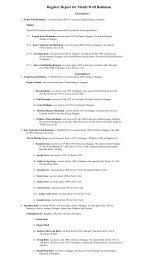
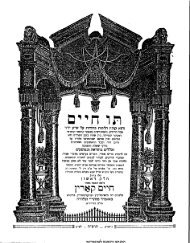
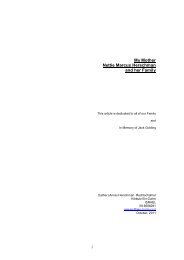
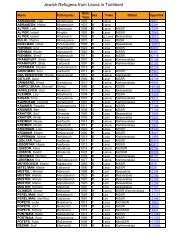
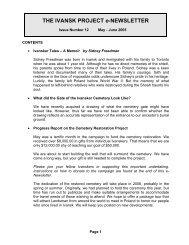
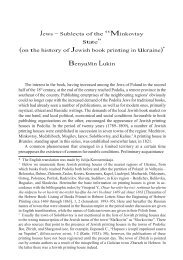
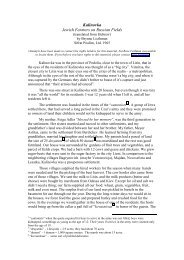
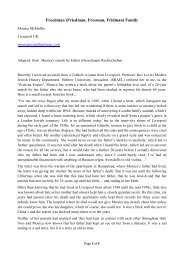
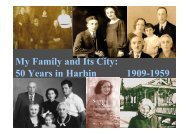

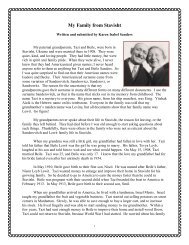

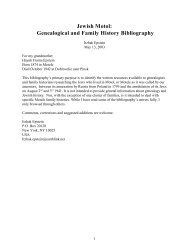
![Carta de Jaime Cesar [Negro] Lipovetzky - JewishGen KehilaLinks](https://img.yumpu.com/19183893/1/190x245/carta-de-jaime-cesar-negro-lipovetzky-jewishgen-kehilalinks.jpg?quality=85)